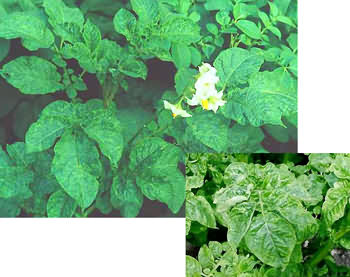Diseases
Potato virus Y potyvirus - Potato Virus Y (PVY)
Systematic position.
Kingdom Vira, Group Potyvirus, family Potyviridae. ICTV decimal code 57.0.1.0.058. Strains: YN (tobacco veinal necrosis strain), YO (common strain), YC (stipple streak strain).Synonyms.
Kartoffel-Y-virus; datura 437 virus; potato acropetal necrosis virus; potato severe mosaic virus; potato virus 20; potato virus Y; tobacco veinal necrosis virus; Solanum virus 2.Biological group.
Obligate parasiteMorphology and biology.
Symptoms on potato plants depend on PVY strain and cultivar, including mild to severe leaf mottling, or streak or leaf-drop streak with vein necrosis (stipple-streak). Virions filamentous, not enveloped, usually flexuous, with clear modal length, 730 nm, 10 nm wide (Delgado-Sanchez and Grogan, 1966). Temperature for the virus inactivation is 52-62.C, limiting dilution . 1:100, loss of infectivity in sap is 48-72 hours. Transmitted by a vector; an insect; Myzus persicae Sulz. is the most efficient vector, others are Aphis nasturtii Kalt., A. fabae Scop., Aulacorthum solani Kalt.Distribution.
Probably, the PVY is distributed worldwide, where potato is grown. In the former USSR, it is distributed everywhere. The disease severity is registered in Byelorussia, Latvia, Lithuania, Moldova, Ukraine, in Northern Caucasus, Central and North-West regions, and in the Far East.Ecology.
Ecological factors influence mainly on the dynamics of aphids numbers. PVY transmission occurs by infected potato tubers; as a result, it can be maintained in potato crop independently of natural foci of the virus.Economic significance.
Broad specialization of PVY allows infecttion of many Solanaceae crops (potato, pepper, tomato, aubergine, etc.) and yield losses can reach 60-80%. PVY is especially harmful in central and southern regions of Russia. The main control methods are virus free seed potato production and growing crops when vectors are absent or their numbers are low.Reference citations:
Ambrosov, A.L. 1975. Viral diseases of potato and crop protection. Minsk: Uradzhai, p. 41-49 (in Russian).Blotskaya, Zh.V. 2000. Viral, viroid and phytoplasma.s diseases of potato. Minsk: Tekhnologia, p. 11-12 (in Russian).
Bokx, de J.A. & Huttinga, H. 1981. Potato virus Y//CMI. AAB Descriptions of Plant Viruses. N 242.
Chesnokov, P.G. 1961. Degeneracy diseases of potato. Leningrad-Moscow: Publishing house of agricultural literature, magazines and posters, p. 240-250 (in Russian).
Loebenstein, G., Berger, P.H., Brunt, A.A., Lawson, R.H., eds. 2000. Virus and virus-like diseases of potato and production of seed potatoes. Dordrecht, Boston, London: Kluwer Academic Publishers, p. 22-25.
Reifmann, V.G. 1966. Viral diseases of potato and their occurrence in the Far East region. In: Viral diseases of potato. Moscow: Nauka, p.95-97 (in Russian).
Shelabina, T.A. 1989. Resistance of potato cultivars to viruses and features of plant protection in the North-west region of Russia. PhD thesis. Leningrad: VIZR, 19 p. (in Russian).
Sozonov, A.N. 2005. Potato virus Y in the North-west region of Russia: distribution, strain structure and preventive measures of this disease. PhD thesis. Saint Petersburg: VIZR, 19 p. (in Russian).
Vlasov, U.I., Larina, E.I. 1982. Agricultural virology. Moscow: Kolos, p. 89-151 (in Russian).
Zikin, A.G. 1970. Aphids - carriers of potato viruses. Leningrad: Kolos, 71 p. (in Russian).
Zikin, A.G. 1976. Viral diseases of potato. Leningrad: Kolos, p. 33-37 (in Russian).


